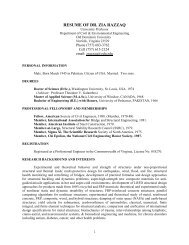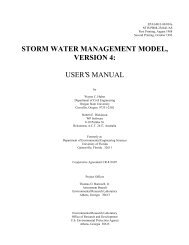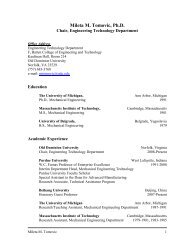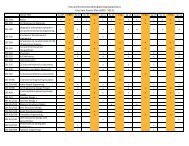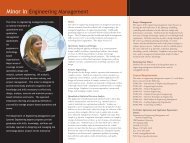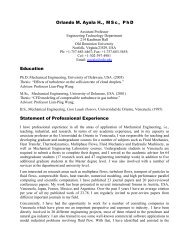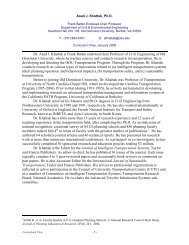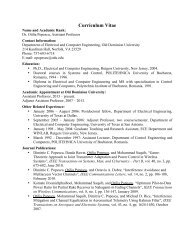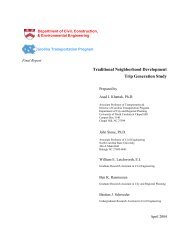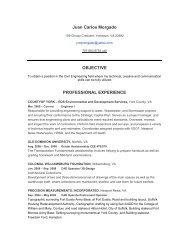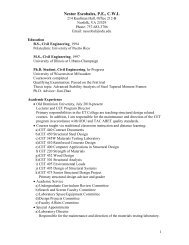Queue length estimation from probe vehicle ... - ResearchGate
Queue length estimation from probe vehicle ... - ResearchGate
Queue length estimation from probe vehicle ... - ResearchGate
You also want an ePaper? Increase the reach of your titles
YUMPU automatically turns print PDFs into web optimized ePapers that Google loves.
ARTICLE IN PRESS2 G. Comert, M. Cetin / European Journal of Operational Research xxx (2008) xxx–xxxtwo examples for an isolated intersection with fixed signal timing.The arrivals are assumed to follow a discrete distribution such asPoisson whereas the <strong>vehicle</strong>s are assumed to queue vertically forsimplicity.It should be noted that there is a vast body of literature onqueues at signalized intersections. Since fixed cycle traffic light allowsa detailed analytical analysis, it has been studied by manyresearchers. One of the earliest studies is by Webster (1958) whogenerated relationships for the number of stops and delays by simulatingtraffic flow on a one-lane approach to an isolated signalizedintersection. In particular, the curve he fitted to the simulation resultshas been fundamental to traffic signal setting proceduressince its development. Miller (1963) found an approximation tothe average overflow queue for any arrival and departure distributions.Later, Newell (1965) derived an analytical approximation tothe mean queue <strong>length</strong> for general arrivals. McNeil (1968) deriveda formula for the expected delay and approximate mean of theoverflow queue <strong>length</strong> for general arrival process and constantdeparture rate.Other than the studies on the <strong>estimation</strong> of mean, there havebeen some attempts to obtain the probability function for thequeue <strong>length</strong>. Some researchers obtained the conditional probabilitydistribution of the overflow queue at the end of one periodgiven the queue <strong>length</strong> at the preceding period assuming homogenousPoisson arrival process (Haight, 1959; Heidemann, 1994;Mung et al., 1996). Yet some others derived the probability generatingfunction (pgf) of the stationary overflow queue (Darroch,1964) in the hope of obtaining the probability functions for delaysand queue <strong>length</strong>s. Obtaining a probability function <strong>from</strong> a pgf involvesinverting the pgf function (Abate and Whitt, 1992), and thisinversion process is quite complicated and entails finding complexroots and numerical evaluations of parameters (Van Leeuwaarden,2006). Therefore, the applicability of this procedure is very limitedand complicated. Following similar methods presented in Haight(1959); Olszewski (1990) used Markov chains to obtain the probabilitydistribution of overflow queue, and developed a computerprogram that estimates the mean queue <strong>length</strong> and its varianceunder different conditions such as stationary and non-stationaryarrival processes, and variable service rates. In a recent paper,Van Zuylen and Viti (2007) also used Markov chains to modelthe dynamics of the probability distributions of the total queueand overflow queue.Lastly, it is interesting to note that the general idea of using<strong>probe</strong>s to estimate the system state or system performance is notunique to vehicular traffic on roadways. In computer communicationnetworks, ‘‘<strong>probe</strong> packets” are sent <strong>from</strong> a source to one ormore receiver nodes in the network in order to deduce the qualityof service or performance (e.g., loss rate, delay) at the internalnodes or links (e.g., routers). In this technique, performance ofthe internal links/nodes is estimated by exploiting the correlationpresent in end-to-end (origin to destination) measurements obtained<strong>from</strong> <strong>probe</strong> packets (e.g., Xi et al., 2006; Duffield, 2006).This article is organized as follows: Section 2 introduces theproblem statement and the notation. Section 3 describes the analyticalformulation for the queue <strong>length</strong> <strong>estimation</strong> problem. Theapplication of the formulation is presented first for a fixed-cycletraffic light without considering the overflow queue in Section 4.Section 5 addresses the application of the formulation when overflowqueue is also considered. Lastly, Section 6 summarizes thefindings and results.<strong>vehicle</strong>s. The main objective is to estimate the total queue <strong>length</strong>,N, if the locations of <strong>probe</strong> <strong>vehicle</strong>s in the queue are known. Technically,the goal is to determine the conditional expected value of Ngiven the <strong>probe</strong> information, and to evaluate the error when thisconditional expected value is used as the predictor of the actualN, where N is the total number of <strong>vehicle</strong>s accumulated in thequeue at the end of red interval.It is assumed that the distance of <strong>probe</strong> <strong>vehicle</strong>s <strong>from</strong> the stopbar can be measured by location tracking technologies. For example,today’s differential GPS systems can provide one to three meteraccuracy (USDOT, 2008). For the purpose of locating <strong>vehicle</strong>s ona link, this accuracy would be sufficient. Once the position of a<strong>vehicle</strong> waiting on the link is known (i.e., distance <strong>from</strong> the stopbar), the number of <strong>vehicle</strong>s ahead of the subject <strong>vehicle</strong> can beestimated by assuming an average <strong>length</strong>/spacing per <strong>vehicle</strong>. Eventhough all <strong>vehicle</strong>s are assumed to be identical in this paper, it ispossible to capture the impact of multiple <strong>vehicle</strong> classes by selectingthe average <strong>vehicle</strong> <strong>length</strong> to be representative of different<strong>vehicle</strong> types. (The concept of using an average or effective <strong>vehicle</strong><strong>length</strong> is common in estimating density and speeds based on occupancy(i.e., percentage of time the detector is occupied/activated)measured by inductive loop detectors (e.g., Hellinga, 2002)). Anotherpossibility to model multiple <strong>vehicle</strong> classes is through specifyingarrival rates for each <strong>vehicle</strong> type. Even though incorporatingmultiple <strong>vehicle</strong> classes (e.g., busses, trucks) into the formulationpresented below is possible, this is avoided to simplify notationand presentation of the main ideas. Furthermore, this paper doesnot discuss information flow architecture and the exact nature ofdata processing needed to obtain the location of <strong>probe</strong>s in thequeue. Albeit important, such details as determining whether a<strong>probe</strong> <strong>vehicle</strong> is in the queue or not (i.e., waiting or moving), whichcan be determined based on its speed, acceleration and selectedthresholds, are not dealt with in this paper.For simplicity, the location of <strong>vehicle</strong>s in queue will be measuredin terms of the number of <strong>vehicle</strong>s. For example, in Fig. 1,there are three <strong>probe</strong> <strong>vehicle</strong>s and the location of the last <strong>probe</strong>,L p , is 6. The value of N is estimated in real-time at the end of eachcycle based on the location of <strong>probe</strong> <strong>vehicle</strong>s. Even though themodels are developed for vertical queues, this figure is includedto clarify the notation. In vertical queuing models, it is assumedthat <strong>vehicle</strong>s do not occupy space and can accelerate and decelerateinstantaneously.The models developed in this paper are based on the assumptionthat only <strong>probe</strong> <strong>vehicle</strong> locations are observable. From a technologicalpoint of view, a system that can collect and use othertypes of data (e.g., arrival times of <strong>probe</strong>s or joining back-of-queueevents) might also be envisioned. However, the scope of this paperis limited to those situations where only location data are used. Asit is demonstrated in the next section, the location of the last <strong>probe</strong>in the queue L p is sufficient for estimating the queue <strong>length</strong>;neither locations of other <strong>probe</strong> <strong>vehicle</strong>s nor the total number of<strong>probe</strong>s <strong>vehicle</strong>s in the queue N p are needed. It is assumedthat the percentage of <strong>probe</strong> <strong>vehicle</strong>s in the traffic stream p isknown.N=72. Problem statement and notationFig. 1 shows a snapshot of traffic at a signalized intersection approachat the end of a red phase. Solid rectangles represent <strong>probe</strong>L p= 6Fig. 1. Snapshot of an intersection right before the red interval terminates.Please cite this article in press as: Comert, G., Cetin, M., <strong>Queue</strong> <strong>length</strong> <strong>estimation</strong> <strong>from</strong> <strong>probe</strong> <strong>vehicle</strong> location and the impacts of samplesize, European Journal of Operational Research (2008), doi:10.1016/j.ejor.2008.06.024



